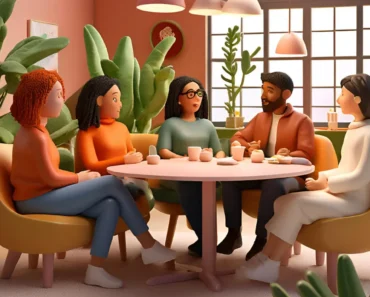Each generation possesses a unique relationship with technology, shaped by the tools available during their formative years. The speed of technological change accelerates with each decade, creating distinct experiences across different age groups. This leads to varying levels of comfort, intuition, and skill with digital tools between generations.
Looking across the age spectrum in the United States, from Baby Boomers who grew up with analog systems to Generation Z (often called Zoomers) who were born into a digital-first world, a technological gap exists. This gap is not about ability, but about how technology was learned and integrated into life. Understanding these differences is crucial for effective communication and connection across generations.
Bridging this tech gap benefits everyone. It helps older generations stay connected and access essential services. It allows younger generations to understand the value of different skill sets and communication styles. Navigating this digital divide requires patience, empathy, and a willingness to learn from one another.
This article explores the technological journeys From Boomers to Zoomers. We examine the unique tech experiences of different generations, discuss the nature of the digital divide, and offer strategies for bridging the tech gap to foster understanding and connection across age groups in the United States.
Understanding the Generational Tech Landscape
The landscape of technology changed dramatically over the past century, creating different environments for each generation as they grew up. Understanding these environments helps explain the varying levels of digital fluency From Boomers to Zoomers.
Baby Boomers, born roughly between 1946 and 1964, grew up in a predominantly analog world. Their careers often began before widespread use of personal computers or the internet. Technology included television, landline phones, and early computing systems used in specialized environments. They learned technology as a tool for specific tasks, often through manuals or formal training later in life.
Generation X, born approximately between 1965 and 1980, witnessed the advent of personal computers and the early internet in their youth and young adulthood. They are often called the “bridge” generation. They adapted as technology evolved, becoming comfortable with desktop computers, email, and early online platforms. They experienced both the analog and digital worlds.
Millennials, born typically between 1981 and 1996, came of age during the dot-com boom, the rise of widespread internet access, social media, and mobile phones. They integrated technology into their social lives and education more seamlessly than previous generations. They are digital pioneers in the sense that they actively navigated the transition to a mobile-first, social-media-dominated digital landscape.
Generation Z, or Zoomers, born from around 1997 to 2012, are true digital natives. They grew up with smartphones, tablets, social media, streaming services, and ubiquitous connectivity as the norm from childhood. The digital world is an integrated part of their environment, used intuitively for communication, learning, and entertainment. Their tech fluency is often based on interacting with user-friendly interfaces.
Each generation learned technology based on the tools available to them. This created different strengths and comfort levels, contributing to the tech gap seen From Boomers to Zoomers.
Baby Boomers: Navigating the Digital Shift
Baby Boomers faced the most significant technological transition in their adult lives. They moved from careers and daily routines based on analog systems to a world increasingly reliant on computers and the internet. Their tech experience involves adaptation.
Many Boomers learned to use computers and email as requirements for their jobs or to stay connected with family. They became proficient with essential software like word processors and spreadsheets. Email became a standard form of communication. They adapted to online banking and shopping as these services developed.
Common challenges for some Boomers involve the pace of technological change. Rapid updates to software, new devices with non-intuitive interfaces, and understanding complex online ecosystems can feel overwhelming. They may find navigating smartphone apps or social media platforms less intuitive than younger generations who grew up with these tools. Understanding digital security threats and avoiding online scams presents another area of challenge for some.
However, many Boomers demonstrate resilience and a willingness to learn. They recognize the benefits of technology for staying connected, accessing information, and managing finances. Their tech skills are often grounded in understanding the purpose of different tools and following logical steps, a skill developed in earlier analog systems. They successfully integrated significant technological changes into their lives.
Their journey involves actively learning new systems as they emerged. This differs from generations who simply grew up using them intuitively. Understanding this difference is key to bridging the tech gap From Boomers to Zoomers.
Generation X: The Bridge Generation
Generation X occupies a unique position regarding technology, often serving as a bridge between the digital immigrants (Boomers and older) and digital natives (Millennials and younger). They grew up as personal computing and the internet became accessible.
Gen X experienced school and early careers with computers becoming standard tools. They used early operating systems, navigated dial-up internet, and adopted email and the first wave of online communication tools. They learned to troubleshoot computer problems and adapt to new software as technology advanced at a steady, but perhaps less frenetic, pace than today.
This generation often exhibits comfort with a range of technologies. They are familiar with older computer systems and software while also adopting new devices and online platforms as needed for work and personal life. They are often equally comfortable communicating via email or instant message, using smartphones or desktop computers.
Their tech experience makes them valuable intermediaries. They can often understand the perspectives of both older individuals who struggle with digital concepts and younger individuals who navigate the digital world with ease. This positioning allows them to explain technology in ways that resonate across different comfort levels, facilitating communication and learning within families and the workplace. Gen X often helps bridge the tech gap From Boomers to Zoomers.
Millennials: Digital Pioneers and Integrators
Millennials came of age as the internet became a pervasive force and mobile technology revolutionized communication and access to information. They actively integrated technology into nearly every aspect of their lives. Their experience differs significantly from earlier generations.
Millennials were among the first to use social media widely for social connection, self-expression, and organizing. They adopted smartphones early, making mobile internet access and apps central to daily routines. They used technology extensively in education, work, and consuming media. Technology became less of a tool and more of an integrated part of their identity and daily functioning.
As they entered adulthood and careers, Millennials drove the adoption of new collaborative tools and digital workflows in the workplace. They expect seamless technology integration in their professional lives. Many are now parents raising Generation Alpha, who are even more immersed in the digital world from infancy.
Millennials’ tech fluency lies in their comfort with integration and their role as early adopters of major digital trends that shaped the modern online landscape. They understand the culture of social media and online communities deeply. While they are comfortable with current technology, their understanding comes from navigating its rapid development, giving them a different perspective than those who grew up with it already in place. Their experience as digital pioneers sets them apart in the journey From Boomers to Zoomers.
Generation Z (Zoomers): True Digital Natives
Generation Z, or Zoomers, represents the first generation to have known only a world with widespread internet access, smartphones, and social media from their earliest memories. Their relationship with technology is characterized by intuition and constant connectivity.
Zoomers interact with technology using intuitive interfaces, touchscreens, and voice commands with a natural ease developed from infancy. They communicate extensively through instant messaging, social media, and video calls. They consume content primarily through streaming platforms and online video channels. The digital world is their default social and informational environment.
Their tech fluency is deeply embedded in using current digital platforms and devices effortlessly. They are quick to adapt to new apps and navigate complex online environments designed for user-friendly interaction. Their skills often involve creating digital content, curating online identities, and participating in online communities.
However, their intuitive use may sometimes come without a full understanding of the underlying technology, digital security risks, or the permanence of online information. They might struggle with less intuitive legacy systems or understanding concepts like file management and privacy settings in depth. Their tech smarts are optimized for the current digital landscape but may not always include the foundational knowledge or critical perspective developed by previous generations. Their native comfort sets them apart in the spectrum From Boomers to Zoomers.
The Nature of the “Tech Gap”
The tech gap From Boomers to Zoomers is not a simple measure of intelligence or capability. It is a difference in the way technology is approached, understood, and used, shaped by the distinct environments each generation grew up in.
One aspect of the gap is comfort and intuition. Zoomers find navigating smartphone apps and online social platforms highly intuitive, a skill developed from constant early exposure. Some Boomers might find these interfaces less natural, requiring conscious learning of steps that feel automatic to younger generations.
Differences exist in preferred communication methods. Boomers may rely more on email and phone calls. Millennials integrated instant messaging and early social media. Zoomers prefer rapid communication through messaging apps, social media direct messages, and visual platforms. Bridging the gap involves recognizing and respecting these differing communication norms.
Learning styles for technology also differ. Older generations often learned technology through structured lessons, manuals, or trial and error on less intuitive systems. Younger generations learn by experimentation, watching online tutorials (often created by their peers), and simply immersing themselves in user-friendly environments.
Understanding digital security and privacy presents another area of difference. While all generations face online risks, their awareness and strategies for protection vary based on when and how they encountered the internet’s darker sides. Older generations may be more susceptible to certain types of scams, while younger generations might share more personal information online without fully grasping the long-term implications. Bridging the gap requires addressing security awareness across all age groups with relevant approaches. The tech gap From Boomers to Zoomers is multifaceted, involving skills, habits, and perspectives.
Read Also: How Tech Redefines Good Parenting in 2025
Strategies for Bridging the Gap
Bridging the tech gap From Boomers to Zoomers requires conscious effort, patience, and a willingness from all sides to learn and teach. It is about building connections and understanding, using technology as a tool for bringing people together.
Empathy and patience are fundamental. Recognize that individuals from different generations learned technology in different environments. What feels intuitive to one group may be completely foreign to another. Approaching learning with patience and understanding removes frustration and encourages open communication.
Embrace mutual learning. The flow of knowledge does not have to be one-way. Younger generations can teach older individuals how to use new devices, navigate social media, or utilize streaming services. Older generations can teach younger individuals about online safety based on years of experience, critical thinking developed through different information landscapes, or using technologies less familiar to Zoomers. This mutual exchange builds respect and shared understanding.
Focus on practical applications. When teaching technology, emphasize how it benefits the individual’s specific needs and interests. Showing a Boomer how to video call grandchildren or access online hobbies provides clear motivation. Showing a Zoomer how to create a professional resume or use online research databases highlights practical skills beyond social media. This makes learning relevant.
Choose the right tools together. Select technologies that are accessible and meet the needs of the learner. Not every new gadget is suitable for everyone. Find devices and platforms with user-friendly interfaces and necessary accessibility features. Technology should simplify life, not complicate it excessively.
Emphasize safe online practices across all generations. Share knowledge about phishing scams, online privacy settings, creating strong passwords, and recognizing misinformation. Each generation faces unique online threats, and shared awareness enhances security for everyone. Bridging the tech gap From Boomers to Zoomers involves building safer online habits collectively.
Facilitate shared digital experiences. Engage in online activities together as a family, such as playing multiplayer games, using video calls to connect, or collaborating on shared digital projects. Shared experiences make learning fun and strengthen intergenerational bonds through technology.
Benefits of Bridging the Gap
Successfully bridging the tech gap From Boomers to Zoomers yields numerous benefits for individuals, families, and society in the United States. It enhances connection, promotes inclusion, and fosters understanding.
Improved intergenerational communication results from shared comfort with communication tools. When family members across generations can easily connect via video calls, messaging apps, or email, it strengthens relationships and increases frequency of contact, regardless of geographic distance.
Increased digital inclusion for older adults opens doors to essential services and opportunities. Proficiency with technology allows Boomers and older generations to access online banking, telehealth services, government resources, social communities, and educational platforms, enhancing independence and quality of life.
Enhanced safety and security for all generations result from shared knowledge about online risks. When families discuss digital security and share tips for avoiding scams or protecting privacy, it reduces vulnerability for everyone, including older adults who may be targeted by financial scams and younger individuals who may face online harassment or privacy risks.
Shared knowledge and new perspectives enrich understanding. Younger generations gain appreciation for the technological shifts their parents and grandparents navigated, fostering empathy. Older generations gain insight into how technology shapes contemporary communication, social norms, and youth culture, fostering connection and reducing misunderstandings.
Bridging the gap promotes a more digitally literate society. When technology skills and understanding are shared across generations, it creates a more informed and capable population better equipped to navigate the complexities and opportunities of the modern digital world. The effort benefits everyone involved in bridging the tech gap From Boomers to Zoomers.
Conclusion: Different Paths to Digital Fluency
Navigating Technology Across Generations
In conclusion, the technological landscape shaped individuals differently, creating a noticeable tech gap From Boomers to Zoomers in the United States. Baby Boomers adapted to digital technology later in life, gaining pragmatic skills. Generation X bridged the analog and digital worlds. Millennials pioneered the mobile and social media era. Generation Z are intuitive digital natives.
Bridging this gap is not about one generation being superior, but about recognizing different strengths and perspectives. Strategies like practicing patience, embracing mutual learning, focusing on practical tech applications, promoting safe online habits, and facilitating shared digital experiences help connect generations.
The benefits of bridging the tech gap are significant, including improved communication, increased digital inclusion, enhanced safety, and shared knowledge. By understanding each other’s technological journeys and committing to mutual learning, individuals From Boomers to Zoomers can navigate the digital world together, strengthening bonds and building a more connected society in the United States.
Frequently Asked Questions About Generational Tech Differences
Who are the different generations discussed From Boomers to Zoomers?
The article discusses Baby Boomers (born roughly 1946-1964), Generation X (1965-1980), Millennials (1981-1996), and Generation Z or Zoomers (1997-2012).
What is the main difference in how Baby Boomers and Zoomers use technology?
Baby Boomers often learned technology as adults, adapting to tools that emerged during their careers. Zoomers grew up with ubiquitous digital technology, using devices and apps intuitively from infancy. The difference lies in adaptation vs. native fluency.
How can younger generations help bridge the tech gap for older generations?
Younger generations can help by patiently teaching older individuals how to use specific devices or apps relevant to their needs (like video calls or social media to connect with family) and focusing on practical benefits.
What can older generations teach younger generations about technology?
Older generations can share insights into critical thinking about online information, understanding digital privacy and security risks based on years of experience with the internet, and the value of different communication methods beyond just digital ones. They can also teach about older tech less familiar to Zoomers.
Why is bridging the tech gap important?
Bridging the tech gap improves communication and connection within families, enhances digital inclusion for older adults to access essential services, increases safety awareness for all generations online, and fosters mutual understanding and respect across age groups in a digital world.





